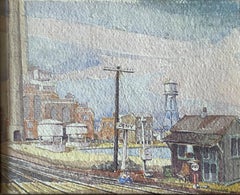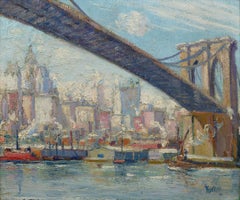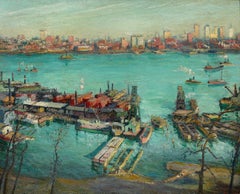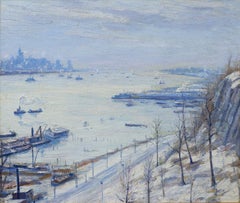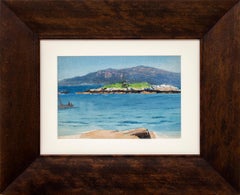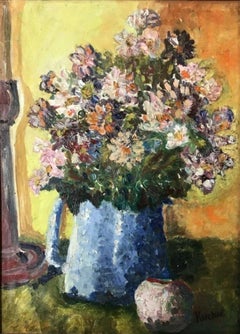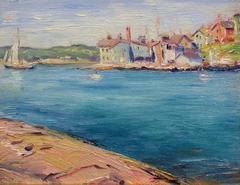Max Kuehne Paintings
American, 1880-1968
Born in Halle, Germany in 1880, Max Kuehne was a colorist who created cheerful landscapes that appear to be painted spontaneously and with freshness.
He studied with William Merritt Chase and Kenneth Hayes at the Chase School in New York. In 1910, he embarked on a bicycling trip, traveling through England, France, Germany, Holland and Belgium. To support this trip he did portrait commissions along the way.
When he returned to New York City, he set up a studio in Greenwich Village and was a student of Robert Henri from whom he learned a dark impressionist style. He also became close with such avant garde artists as Guy Pene du Bois, William Glackens, William Zorach and Maurice and Charles Prendergast, which also influenced his dark work including street scenes and docks in New York City. However, three years in Spain, and painting trips to Gloucester lightened his palette as did time in Paris where he was much influenced by the Fauves, Nabis, and decorative painters. By 1912 he was producing work that would make him known as a "colourist of great distinction" by producing "paintings full of sparkling sunlight."
He became a member of the artistic community later in Rockport, Massachusetts, with Gifford Beal, Leon Kroll, Paul Manship, Edward Hopper and Jonas Lie. Many of his finest paintings done later in his career are of the busy harbors and piers of Gloucester and Rockport.
His work was widely exhibited including the National Academy of Design, the Art Institute of Chicago, and the Carnegie Institute in Pittsburgh.to
1
3
1
1
Overall Width
to
Overall Height
to
5
3
1
2
5
1
1
1
1
1
1
1
1
5
4
3
3
1
8
785
701
652
646
5
5
Artist: Max Kuehne
Provincetown
By Max Kuehne
Located in Milford, NH
A colorful impressionist coastal oil painting of Provincetown by German / American artist Max Kuehne (1880-1968). Kuehne was born in Halle, Germany, and emigrated to Flushing, New Y...
Category
Mid-20th Century American Impressionist Max Kuehne Paintings
Materials
Oil, Panel
"Train Station, " Max Kuehne, Industrial City Scene, American Impressionism
By Max Kuehne
Located in New York, NY
Max Kuehne (1880 - 1968)
Train Station, circa 1910
Watercolor on paper
8 1/4 x 10 1/4 inches
Signed lower right
Provenance:
Private Collection, Illinois
Max Kuehne was born in Halle, Germany on November 7, 1880. During his adolescence the family immigrated to America and settled in Flushing, New York. As a young man, Max was active in rowing events, bicycle racing, swimming and sailing. After experimenting with various occupations, Kuehne decided to study art, which led him to William Merritt Chase's famous school in New York; he was trained by Chase himself, then by Kenneth Hayes Miller. Chase was at the peak of his career, and his portraits were especially in demand. Kuehne would have profited from Chase's invaluable lessons in technique, as well as his inspirational personality. Miller, only four years older than Kuehne, was another of the many artists to benefit from Chase's teachings. Even though Miller still would have been under the spell of Chase upon Kuehne's arrival, he was already experimenting with an aestheticism that went beyond Chase's realism and virtuosity of the brush. Later Miller developed a style dependent upon volumetric figures that recall Italian Renaissance prototypes.
Kuehne moved from Miller to Robert Henri in 1909. Rockwell Kent, who also studied under Chase, Miller, and Henri, expressed what he felt were their respective contributions: "As Chase had taught us to use our eyes, and Henri to enlist our hearts, Miller called on us to use our heads." (Rockwell Kent, It's Me O Lord: The Autobiography of Rockwell Kent. New York: Dodd, Mead and Co., 1955, p. 83). Henri prompted Kuehne to search out the unvarnished realities of urban living; a notable portion of Henri's stylistic formula was incorporated into his work.
Having received such a thorough foundation in art, Kuehne spent a year in Europe's major art museums to study techniques of the old masters. His son Richard named Ernest Lawson as one of Max Kuehne's European traveling companions. In 1911 Kuehne moved to New York where he maintained a studio and painted everyday scenes around him, using the rather Manet-like, dark palette of Henri.
A trip to Gloucester during the following summer engendered a brighter palette. In the words of Gallatin (1924, p. 60), during that summer Kuehne "executed some of his most successful pictures, paintings full of sunlight . . . revealing the fact that he was becoming a colorist of considerable distinction." Kuehne was away in England the year of the Armory Show (1913), where he worked on powerful, painterly seascapes on the rocky shores of Cornwall. Possibly inspired by Henri - who had discovered Madrid in 1900 then took classes there in 1906, 1908 and 1912 - Kuehne visited Spain in 1914; in all, he would spend three years there, maintaining a studio in Granada. He developed his own impressionism and a greater simplicity while in Spain, under the influence of the brilliant Mediterranean light. George Bellows convinced Kuehne to spend the summer of 1919 in Rockport, Maine (near Camden). The influence of Bellows was more than casual; he would have intensified Kuehne's commitment to paint life "in the raw" around him.
After another brief trip to Spain in 1920, Kuehne went to the other Rockport (Cape Ann, Massachusetts) where he was accepted as a member of the vigorous art colony, spearheaded by Aldro T. Hibbard. Rockport's picturesque ambiance fulfilled the needs of an artist-sailor: as a writer in the Gloucester Daily Times explained, "Max Kuehne came to Rockport to paint, but he stayed to sail." The 1920s was a boom decade for Cape Ann, as it was for the rest of the nation. Kuehne's studio in Rockport was formerly occupied by Jonas Lie.
Kuehne spent the summer of 1923 in Paris, where in July, André Breton started a brawl as the curtain went up on a play by his rival Tristan Tzara; the event signified the demise of the Dada movement. Kuehne could not relate to this avant-garde art but was apparently influenced by more traditional painters — the Fauves, Nabis, and painters such as Bonnard. Gallatin perceived a looser handling and more brilliant color in the pictures Kuehne brought back to the States in the fall. In 1926, Kuehne won the First Honorable Mention at the Carnegie Institute, and he re-exhibited there, for example, in 1937 (Before the Wind). Besides painting, Kuehne did sculpture, decorative screens, and furniture work with carved and gilded molding. In addition, he designed and carved his own frames, and John Taylor Adams encouraged Kuehne to execute etchings. Through his talents in all these media he was able to survive the Depression, and during the 1940s and 1950s these activities almost eclipsed his easel painting. In later years, Kuehne's landscapes and still-lifes show the influence of Cézanne and Bonnard, and his style changed radically.
Max Kuehne died in 1968. He exhibited his work at the National Academy of Design, the Art Institute of Chicago, the Carnegie Institute in Pittsburgh, the Memorial Art Gallery of the University of Rochester, and in various New York City galleries. Kuehne's works are in the following public collections: the Detroit Institute of Arts (Marine Headland), the Whitney Museum (Diamond Hill...
Category
1910s American Impressionist Max Kuehne Paintings
Materials
Paper, Watercolor
Brooklyn Bridge
By Max Kuehne
Located in New York, NY
Max Kuehne paints a view of The Brooklyn Bridge from below, while boats traverse the river underneath and the New York skyline rises across the water in his oil painting, “Brooklyn B...
Category
1910s Max Kuehne Paintings
Materials
Canvas, Oil, Board
New York Skyline
By Max Kuehne
Located in New York, NY
Max Kuehne paints a dockyard across the river from the skyscrapers of New York City in his artwork entitled, “New York Skyline”
Category
1920s Max Kuehne Paintings
Materials
Canvas, Oil
Water View of New York, 1911
By Max Kuehne
Located in New York, NY
In his oil painting, “Water View of New York, 1911,” Max Kuehne paints the Hudson river from a vantage point atop the palisades. The New York skyline ris...
Category
1910s Max Kuehne Paintings
Materials
Canvas, Oil
Related Items
Canyon Country
By Lu Haskew
Located in Loveland, CO
Canyon Country by Lu Haskew
Pastel 16x20" image size
Landscape view of the Grand Canyon
ABOUT THE ARTIST: Lu Haskew 1921-2009
"Life is good to me. Being able to go to my studio five days weekly and paint for several hours, living in a supportive community, having family and friends who encourage me--all have contributed to helping me become an artist. Being fortunate to study with some of the artists I admire has kept me painting from the garden, people and my favorite things. With the support of galleries, teaching and doing demos, how could I do anything else? My goal is to try to be the best I can be by always being a student, looking for new ideas and stretching my horizons."
Upon retirement from a 33-year teaching career, Lu rented a studio in Loveland and began concentrating on
her oil and watercolor painting. Learning from artists she had followed and admired throughout the years
her painting became a full time career. Since 1992, she has studied with renowned painters Richard
Schmid, Clyde Aspevig, Joyce Pike, and others at the Scottsdale Art...
Category
1990s American Impressionist Max Kuehne Paintings
Materials
Watercolor
19th Century 1925 California Coast Marine Landscape Watercolor, Rocks & Waves
By Charles Partridge Adams
Located in Denver, CO
American Impressionist California coastal watercolor painting by Charles Partridge Adams (1858-1942), circa 1925. This stunning piece captures the beauty of the coastline with vibran...
Category
1920s American Impressionist Max Kuehne Paintings
Materials
Watercolor
H 12.25 in W 15.25 in D 2.5 in
Amercan Merchant Ship in Philadelphia Harbor
By Thomas Birch
Located in Costa Mesa, CA
Thomas Birch is considered one of the earliest American Marine painters of importance both in his own time and historically, forming the foundation of what would become a great American Maritime movement in the successive years of the 19th century.
Born in England, Birch started as a landscape painter but after the War of 1812 he turned to marine subjects, taking inspiration from the best of both English and Dutch maritime traditions but refining these techniques into a very recognizable style all his own.
The work featured here is a classic of Birch's later period, when he focused specifically on maritime subjects, mainly the busy waterways of Philadelphia Harbor. Here we see one of those scenes- a series of ships plying their trade, all framed by the city as it sits across the Delaware River, with the tall, white spire of what is either Independence Hall or Christ Church to the left of the main vessel. The details of the city are particularly good in this painting, with the wharf building to the left and the long line of buildings all along the shore.
The American Merchant Bark at the center of this painting is rendered in excellent detail, from her house flag and pennant, to her rigging and sails, and down to her deck filled with the activity of crewmembers readying the ship to head out, her gilt billet...
Category
1840s Other Art Style Max Kuehne Paintings
Materials
Canvas, Oil, Board
"Eastern Plains of Colorado" By Sparky LeBold, Colorado Landscape Oil Painting
Located in Denver, CO
"Eastern Plains of Colorado" by Sparky LeBold (US and Portugal based) is a beautiful handmade oil painting that depicts a view of the vast green plains of Colorado, with the famed su...
Category
2010s American Impressionist Max Kuehne Paintings
Materials
Oil, Panel
"Mt. Evans and Bierstadt, Colorado" Oil Painting
Located in Denver, CO
David Shingler's (NC based) "Mt. Evans and Bierstadt, Colorado" is an oil painting that depicts a green grassy plain dotted with Pine trees leading to the snow capped mountains in th...
Category
2010s American Impressionist Max Kuehne Paintings
Materials
Oil, Wood Panel
19th C. American Impressionist Gouache of Colorado Mountains in Spring
By Charles Partridge Adams
Located in Denver, CO
This original circa 1910s plein air field study by renowned Colorado landscape artist Charles Partridge Adams captures the serene beauty of the Rocky Mountains in a masterful display...
Category
1910s American Impressionist Max Kuehne Paintings
Materials
Gouache
H 13.75 in W 17.75 in D 0.75 in
1930s French Impressionist Watercolour of Children in an Idyllic Country Scene
Located in Cotignac, FR
French Impressionist watercolour on paper view of children in an idyllic country scene by Henri Clamen. Signed bottom right. Acquired from the atelier of the artist with other signed works. Pencil annotation top right and to the back of the paper.
A charming view of two children waiting in the shade of a beautiful summers day by the side of a country lane. An archway through to a farmyard and a farmhouse beyond. Dappled light through the overhead leaves and branches. In the lane to the left a hay wain...
Category
Early 20th Century Impressionist Max Kuehne Paintings
Materials
Ink, Paper, Watercolor
African House
Located in Metairie, LA
Clementine Hunter, African House
This is an excellent example of Hunter’s work, featuring the iconic African House. Three figures are present in the work, a boy, a girl, and an elde...
Category
1960s Folk Art Max Kuehne Paintings
Materials
Canvas, Oil, Board, Pencil
"As you Wish" Oil Painting
Located in Denver, CO
Clyde Steadman's "As you Wish" is an original, handmade oil painting that depicts an impasto painting of a bison in profile.
Category
2010s American Impressionist Max Kuehne Paintings
Materials
Oil, Panel
Untitled
Located in Berlin, MD
Stanley Sporny (American 1946 - 2008) A view into a stream with overhanging branches reflected in the water. A beautiful oil painting that explores the stream bottom as well as the ...
Category
Late 20th Century Abstract Impressionist Max Kuehne Paintings
Materials
Canvas, Oil
"Canal at Indian Mound Road" RARE Ben Fenske Gouache work on paper black & white
By Ben Fenske
Located in Sag Harbor, NY
Painted during the 2015 Winter Equestrian Festival in Wellington, Florida. A black and white depiction of a canal, is barely recognizable, due to Fenske's wild brushstrokes and lack...
Category
21st Century and Contemporary American Impressionist Max Kuehne Paintings
Materials
Paper, Gouache
Spanish Flamenco Dancing Women in Garden, Oil on Canvas.
Located in Stockholm, SE
A fine painting of a group of Spanish flamenco dancing and music playing women in a garden outside a house painted by Allan Österlind (1855-1938). Oil ...
Category
Early 20th Century Other Art Style Max Kuehne Paintings
Materials
Canvas, Oil, Board
H 28.55 in W 22.05 in D 1.97 in
Previously Available Items
"Floral Still Life in a Blue Vase" American Impressionist
By Max Kuehne
Located in New York, NY
Max Kuehne (1880 - 1968)
Floral Still Life
Oil on board
16 x 12 inches
Signed lower right: Kuehne
Provenance:
Wilma and Ronald J. Baird, Philadelphia
Private Collection, Rhode Island
Exhibited:
Philadelphia, Mann Center for Older People, May 1968.
Germantown, Pennsylvania, Young Women's Christian Association, May - June 1973.
Max Kuehne was born in Halle, Germany on November 7, 1880. During his adolescence the family immigrated to America and settled in Flushing, New York. After experimenting with various occupations, Kuehne decided to study art, which led him to William Merritt Chase's famous school in New York; he was trained by Chase himself, then by Kenneth Hayes Miller. Chase was at the peak of his career, and his portraits were especially in demand. Kuehne would have profited from Chase's invaluable lessons in technique, as well as his inspirational personality. Miller, only four years older than Kuehne, was another of the many artists to benefit from Chase's teachings. Even though Miller still would have been under the spell of Chase upon Kuehne's arrival, he was already experimenting with an aestheticism that went beyond Chase's realism and virtuosity of the brush. Later Miller developed a style dependent upon volumetric figures that recall Italian Renaissance prototypes.
Kuehne moved from Miller to Robert Henri in 1909. Rockwell Kent, who also studied under Chase, Miller, and Henri, expressed what he felt were their respective contributions: "As Chase had taught us to use our eyes, and Henri to enlist our hearts, Miller called on us to use our heads." Henri prompted Kuehne to search out the unvarnished realities of urban living; a notable portion of Henri's stylistic formula was incorporated into his work.
Having received such a thorough foundation in art, Kuehne spent a year in Europe's major art museums to study techniques of the old masters. His son Richard named Ernest Lawson as one of Max Kuehne's European traveling companions. In 1911 Kuehne moved to New York where he maintained a studio and painted everyday scenes around him, using the rather Manet-like, dark palette of Henri. He also became close with such avant garde artists as Guy Pene du Bois, William Glackens, William Zorach and Maurice and Charles Prendergast, which also influenced his dark work including street scenes and docks in New York City.
A trip to Gloucester during the following summer engendered a brighter palette. In the words of Gallatin, during that summer Kuehne "executed some of his most successful pictures, paintings full of sunlight . . . revealing the fact that he was becoming a colorist of considerable distinction." Kuehne was away in England the year of the Armory Show (1913), where he worked on powerful, painterly seascapes on the rocky shores of Cornwall. Possibly inspired by Henri - who had discovered Madrid in 1900 then took classes there in 1906, 1908 and 1912 - Kuehne visited Spain in 1914; in all, he would spend three years there, maintaining a studio in Granada. He developed his own impressionism and a greater simplicity while in Spain, under the influence of the brilliant Mediterranean light. George Bellows convinced Kuehne to spend the summer of 1919 in Rockport, Maine (near Camden). The influence of Bellows was more than casual; he would have intensified Kuehne's commitment to paint life "in the raw" around him.
After another brief trip to Spain in 1920, Kuehne went to the other Rockport (Cape Ann, Massachusetts) where he was accepted as a member of the vigorous art colony, spearheaded by Aldro T. Hibbard. Rockport's picturesque ambiance fulfilled the needs of an artist-sailor: as a writer in the Gloucester Daily Times explained, "Max Kuehne came to Rockport to paint, but he stayed to sail." The 1920s was a boom decade for Cape Ann, as it was for the rest of the nation. Kuehne's studio in Rockport was formerly occupied by Jonas Lie. He became a member of the artistic community later in Rockport, Massachusetts, with Gifford Beal, Leon Kroll, Paul Manship, Edward Hopper and Jonas Lie. Many of his finest paintings done later in his career are of the busy harbors and piers of Gloucester and Rockport.
Kuehne spent the summer of 1923 in Paris, where in July, André Breton started a brawl as the curtain went up on a play by his rival Tristan Tzara; the event signified the demise of the Dada movement. Kuehne could not relate to this avant-garde art but was apparently influenced by more traditional painters — the Fauves, Nabis, and painters such as Bonnard. Gallatin perceived a looser handling and more brilliant color in the pictures Kuehne brought back to the States in the fall. In 1926, Kuehne won the First Honorable Mention at the Carnegie Institute, and he re-exhibited there, for example, in 1937 (Before the Wind). Besides painting, Kuehne did sculpture, decorative screens, and furniture work with carved and gilded molding. In addition, he designed and carved his own frames, and John Taylor Adams encouraged Kuehne to execute etchings. Through his talents in all these media he was able to survive the Depression, and during the 1940s and 1950s these activities almost eclipsed his easel painting. In later years, Kuehne's landscapes and still-lifes show the influence of Cézanne and Bonnard, and his style changed radically.
Max Kuehne died in 1968. He exhibited his work at the National Academy of Design, the Art Institute of Chicago, the Carnegie Institute in Pittsburgh, the Memorial Art Gallery of the University of Rochester, and in various New York City galleries. Kuehne's works are in the following public collections: the Detroit Institute of Arts (Marine Headland), the Whitney Museum (Diamond Hill...
Category
Mid-20th Century American Impressionist Max Kuehne Paintings
Materials
Paint, Oil, Board
Sailing Out of Harbor
By Max Kuehne
Located in Wiscasset, ME
Born in Halle, Germany in 1880, artist Max Kuehne studied at William Merritt Chase’s school in New York under Chase, then Kenneth Hayes Miller and in 1909, was a pupil of Robert Henr...
Category
1920s Impressionist Max Kuehne Paintings
Materials
Oil, Board
A Village Church Near Baya
By Max Kuehne
Located in Fairlawn, OH
Signed by the artist lower right: Kuehne
Signed, dated and titled "A Village Church near Baya (sic)" by the artist in pencil verso.
Category
1920s Max Kuehne Paintings
Max Kuehne paintings for sale on 1stDibs.
Find a wide variety of authentic Max Kuehne paintings available for sale on 1stDibs. You can also browse by medium to find art by Max Kuehne in paint, oil paint, canvas and more. Much of the original work by this artist or collective was created during the 20th century and is mostly associated with the Impressionist style. Not every interior allows for large Max Kuehne paintings, so small editions measuring 16 inches across are available. Customers who are interested in this artist might also find the work of William Lester Stevens, Frank Vincent Dumond, and Charles Hargens. Max Kuehne paintings prices can differ depending upon medium, time period and other attributes. On 1stDibs, the price for these items starts at $2,800 and tops out at $65,000, while the average work can sell for $5,900.
